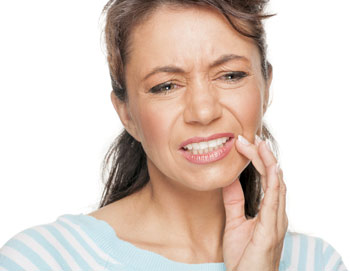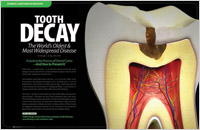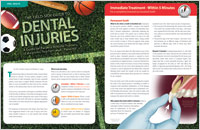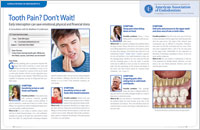When you have a dental emergency — whether it's caused by a sudden accident or chronic disease — your teeth and/or the tissues of the mouth that surround them need to receive proper care right away. As with any type of medical emergency, it's important to be aware, before you're actually in the situation, of what you can do to ensure the best outcome.
Traumatic Dental Injuries
 A knocked-out permanent tooth requires quick thinking and immediate action. You'll increase the chances that the tooth can be saved if you pick it up without touching the root, gently clean it off with water, and put it back in its socket facing the correct way. Hold it in place with gentle pressure as you rush to the dental office or emergency room. If you can't replant it immediately, tuck it between the patient's cheek and gum, or carry it in a container of cold milk.
A knocked-out permanent tooth requires quick thinking and immediate action. You'll increase the chances that the tooth can be saved if you pick it up without touching the root, gently clean it off with water, and put it back in its socket facing the correct way. Hold it in place with gentle pressure as you rush to the dental office or emergency room. If you can't replant it immediately, tuck it between the patient's cheek and gum, or carry it in a container of cold milk.
For a more traumatic injury such as a tooth that has been moved or loosened, treatment needs to occur within six hours. However, if there is uncontrollable bleeding, go immediately to the ER. Fortunately, other dental injuries that happen most frequently are less severe. The most common traumatic dental injuries are chipped teeth. If a tooth is chipped, try to find any pieces that have come off, as it might be possible to reattach them. Make an appointment for an office visit as soon as possible, and bring the pieces with you.
Learn more about Traumatic Dental Injuries .
Tooth Pain
 Acute or persistent tooth pain always signals a need for an urgent visit to the dental office. The most common cause of dental pain is tooth decay, a bacterial infection that can spread through many parts of the tooth, and even into the gum tissue. Sometimes, tooth pain indicates that you may need a root canal treatment — a procedure that not only relieves the pain of an infection deep inside the tooth, but also can keep the tooth from having to be removed. Other times, pain may be caused by a loose filling or sensitive tooth. The only way to know for sure what's causing your tooth pain is to make an appointment at the dental office right away.
Acute or persistent tooth pain always signals a need for an urgent visit to the dental office. The most common cause of dental pain is tooth decay, a bacterial infection that can spread through many parts of the tooth, and even into the gum tissue. Sometimes, tooth pain indicates that you may need a root canal treatment — a procedure that not only relieves the pain of an infection deep inside the tooth, but also can keep the tooth from having to be removed. Other times, pain may be caused by a loose filling or sensitive tooth. The only way to know for sure what's causing your tooth pain is to make an appointment at the dental office right away.
Learn more about Tooth Pain .
Gum Emergencies
Injuries and infections involving the soft tissues of the mouth may also require emergency treatment. The tissues of the gums, tongue, or cheek lining can be damaged by accidental bites, falls, sports injuries, and scalding liquids. They may also suffer injury from foreign bodies that become lodged below the gum line, and they can develop painful and potentially serious abscesses. A periodontal (gum) abscess is a pus-filled sac caused by an infection and is usually quite painful. Abscesses require immediate attention at the dental office.
Any injury to the soft tissues of the mouth should be rinsed with dilute salt water. If there is visible debris, it should be cleared. Bleeding can usually be controlled by pressing a clean, damp material to the area for 10-15 minutes. If this does not work, go to the emergency room immediately.
A foreign body lodged beneath the gum line can sometimes be gently worked out with dental floss or a toothpick. But if this can't be accomplished easily, make a dental appointment so the area does not become damaged and/or infected.
Learn more about Gum Emergencies .
Orthodontic Emergencies
Although there can be discomfort associated with orthodontic treatment, there are only a few true orthodontic emergencies. They include trauma or injury to the teeth, face or mouth. Infection or swelling of the gums, mouth or face, and severe, unmanageable discomfort or pain in these areas can also be orthodontic emergencies. In any of these situations, seek immediate care from the dental office or emergency room — whichever is your best option. For loose, broken or irritating pieces of orthodontic hardware, please call the dental office for advice.
Learn more about Orthodontic Emergencies .
If A Permanent Tooth Is Knocked Out
Many dental emergencies require immediate attention, or the patient may suffer from complications or even tooth loss. If a permanent tooth is knocked out, time is critical. Ideally, the tooth should be replaced into the socket at the accident site. The patient should be rushed to the dentist, who will then splint the tooth into place by using orthodontic wire or bonding material. If the tooth cannot be immediately replaced into the socket, it should be held in the mouth in the patient's cheek or under the tongue. It is also possible to place the tooth into a glass of milk or a glass of water with a small pinch of salt. Do not try to clean any tissue from the tooth because this is an important element in allowing reattachment of the tooth. The ADA advises the patient be brought to the dentist within thirty minutes. A successful reimplantation will be less likely if the tooth is out for an extended period of time. Unfortunately, if a baby tooth is prematurely lost due to accident or injury, it cannot be reimplanted. Do not try to replace lost baby teeth.
Treatment Of Fractured Teeth
The upper front teeth are the most frequently traumatized, and they sustain about 80% of all dental injuries. The incidence of injury is greatly increased if the teeth are bucked and protrude beyond the lip line. In such instances, early orthodontic treatment sometimes is advised to pull the teeth back in line. Infants and toddlers are particularly susceptible to traumatic injuries because they lack coordination. Trauma may cause the displacement or loosening of teeth in young children. With older children or adults, trauma often results in damage to the permanent tooth in the crown (the part of the tooth above the gum) or root fracture. If the crown of the tooth is fractured in an accident, be sure to save the broken piece. Many times it can be bonded back into place.
It is estimated that anywhere from 13% to 39% of all dental injuries are sports related. It is for this reason the American Dental Association recommends that children and adults who participate in sports such as football, basketball, wrestling, soccer, rugby, and other contact sports wear mouth guards to protect against these types of injuries.
Dental Infection
In the event of dental swelling due to infection, contact our office immediately. If you are running a temperature, having difficulty swallowing, or experiencing trouble breathing, the infection could be serious. Untreated dental infection can result in systemic illness, hospitalization, and even death. The best way to avoid this problem is to maintain regularly scheduled checkup appointments. In this way, we can find problems when they are small and avoid any crisis situations.
If there is any question as to what to do in case of an emergency, please do not hesitate to contact our office.
Oral Cancer
Early detection of oral cancer not only is possible but also may save your life. If cancer of the mouth is discovered and treated early, the five year survival rate is 76%, but it is only 19% when the cancer spreads from the mouth to other parts of the body. The current overall survival rate for oral cancer is only 50%.
Some of the early warning signs of oral cancer are a soreness or swelling that doesn't go away; a sore in the mouth that bleeds easily or doesn't heal; and a lump, thickening, or soreness of the mouth, tongue, or throat. Oral cancer may appear in the mouth as a white or red patch that doesn't heal. One may notice that it is difficult to chew, swallow, or move the tongue or jaw. Symptoms may also include numbness of the tongue or other areas of the mouth. A denture may suddenly not fit, or it may become uncomfortable to wear due to a growth. Any white or red lesion that is present in the mouth for more than two weeks should be evaluated and considered for a biopsy, if indicated, to insure an accurate diagnosis.
Oral Cancer Signs and Symptoms:
This list considers both oral cancers from HPV and those from tobacco and alcohol
- An ulcer or sore that does not heal within 2-3 weeks
- A red, white, or black discoloration on the soft tissues in the mouth
- Difficult or painful swallowing. A sensation that things are sticking in the throat when swallowing
- A swollen but painless tonsil. When looking in the mouth, tonsils on both sides should be symmetrical in size
- Pain when chewing
- A persistent sore throat or hoarse voice
- A swelling or lump in the mouth
- A painless lump felt on the outside of the neck, which has been there for at least two weeks.
- A numb feeling in the mouth or lips
- Constant coughing
- An earache on one side (unilateral) that persists for more than a few days.
The use of tobacco and excessive use of alcohol will increase the risk of oral cancer. If both tobacco and alcohol are used together, the risk is much greater than if either substance was used alone. Many people mistakenly think that cigars are not as harmful as cigarettes because the smoke is not inhaled. Cigars cause an increased chance for oral cancer because the smoke is held in the mouth longer. Chewing tobacco also increases the incidence of oral cancer because the tobacco is held in the mouth for extended periods of time. In addition, chewing tobacco contains sand, which is extremely abrasive to the teeth and causes erosion, as well as large amounts of sugar that causes an increase in the decay rate.
Exposure to ultraviolet radiation from sunlight or from a tanning bed increases your risk for cancer of the lips. Advanced age carries an increased risk for oral cancer because the longer you live, the more exposure you have had to cancer causing agents. The greatest incidence of oral cancers occurs in people from sixty-five to seventy-four years of age. Oral cancer can appear about ten years sooner in African Americans. Men are affected with oral cancer about twice as often as women. It occurs more frequently in African Americans than in Caucasians.
Risk factors
Factors that can increase your risk of mouth cancer include:
- Tobacco use of any kind, including cigarettes, electronic cigarettes, cigars, pipes, chewing tobacco and snuff, among others
- Heavy alcohol use
- Excessive sun exposure to your lips
- A sexually transmitted virus called human papillomavirus (HPV)
- A weakened immune system
HPV and Oral Cancer:
HPV oral and oropharyngeal cancers are harder to discover than tobacco related cancers because the symptoms are not always obvious to the individual who is developing the disease, or to professionals that are looking for it. They can be very subtle and painless. A dentist or doctor should evaluate any symptoms that you are concerned with, and certainly anything that has persisted for two or more weeks. Although there are many adjunctive oral cancer screening devices and tests, not all of them can find HPV positive oral and oropharyngeal cancers. The best way to screen for HPV related oral and oropharyngeal cancer today is through a visual and tactile exam given by a medical or dental professional, who will also do an oral history taking to ask about signs and symptoms that cover things that are not visible or palpable. Like other cancer screenings you engage in, such as cervical, skin, prostate, colon and breast examinations, opportunistic oral cancer screenings are an effective means of finding cancer at its early, highly curable stages. However like many other cancer screening techniques, this process is not 100% effective, and any screening technique or technology can miss things. This is why it is so important that persistent problems, those which do not resolve in a short period of time like 2-3 weeks, are pursued until a definitive diagnosis is established.
- HPV is the leading cause of oropharyngeal cancers (the very back of the mouth and part of what in lay terms might be called a part of the throat), and a very small number of front of the mouth, oral cavity cancers. HPV16 is the version most responsible, and affects both males and females.
- In public messages for simplicity, the Oral Cancer Foundation frequently speaks about oral cancers in general. Scientifically, this is really anatomically divided up into the oral cavity and the oropharynx. Each anatomical site has different statistics, etiologies which dominate that location, and outcomes from treatment. The fastest growing segment of the oral and oropharyngeal cancer population are otherwise healthy, non-smokers in the 25-50 age range. When you consider both anatomical sites, HPV is driving the growth in numbers of oral cancers.
- White, non-smoking males age 35 to 55 are most at risk, 4 to 1 over females.
- In the oral/oropharyngeal environment, HPV16 manifests itself primarily in the posterior regions (the oropharynx) such as the base of the tongue, the back of the throat, the tonsils, the tonsillar crypts, and tonsillar pillars.
When you come in for your oral examination, we will routinely do an oral cancer screening examination. If you have an area of concern, please be sure to let us know. If you smoke or use any tobacco products, we would be happy to talk to you about available products to help you stop. Over 95% of mouth cancers occur in people over forty years old, and unlike some cancers, they can be successfully treated if detected early. By doing a self-examination of your mouth on a regular basis and visiting your dental professionals regularly, you can reduce your risk of oral cancer and maintain the health of your mouth.
Related Articles

Tooth Decay — A Preventable Disease Tooth decay is the number one reason children and adults lose teeth during their lifetime. Yet many people don't realize that it is a preventable infection. This article explores the causes of tooth decay, its prevention, and the relationship to bacteria, sugars, and acids... Read Article

The Field-Side Guide to Dental Injuries Accidents to the teeth, jaws and mouth can happen at any time during any sporting activity. Proper attention can save pain, alleviate anxiety and costly dental treatment. A little knowledge, as they say, can go along way. This field-side guide briefly explains some simple rules to follow when dealing with different dental injuries and when you need to see the dentist... Read Article

Tooth Pain? Don't Wait! Pain is a protective response that informs the body that something is wrong. Tooth pain, specifically, is caused by a reaction of the nerves inside a tooth's pulp chamber, with the severity dependent upon the type and degree of the stimulus. This article gives some examples of pain symptoms and their possible causes... Read Article







